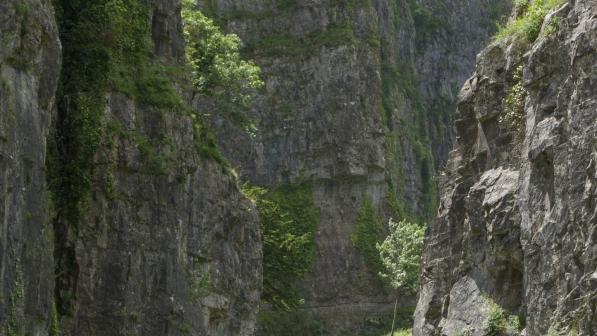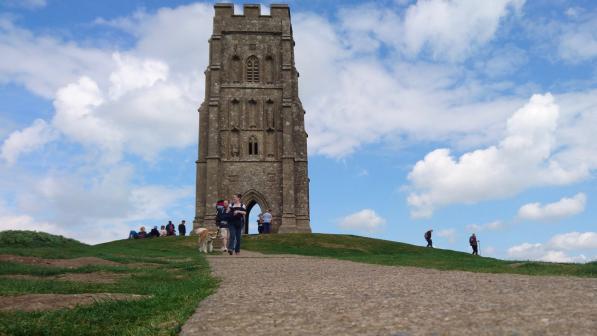Cycling to Glastonbury

To the south of the village of Pilton, in Somerset, lies a quiet, pretty valley. The countryside is quintessentially English – rolling pastureland, copses of trees, bustling hedgerows. A handful of narrow lanes intersect the farmland, and apart from the odd tractor, you’re unlikely to encounter much traffic. Idyllic terrain for cycling, particularly in early summer when the scenery is at its most vibrant.
But come spinning along one of these lanes in late June, and you will find an altogether different proposition. A whole city transplants itself into this valley for one feted long weekend. Glastonbury Festival, the most famous festival for the performing arts in the world, and the largest on a greenfields site, with 175,000 visitors every year.
Since its inception in 1970, Glastonbury Festival has been phenomenally successful. If you’re a band, it’s the festival to play. And if you’re a music fan, it’s the festival to attend. Inevitably, it’s become something of a corporate entity, and some would say it’s no longer cutting edge, but there is still a strong counter-culture feel to it, and it makes a significant contribution to charitable causes (principal charities are Wateraid, Oxfam and Greenpeace).
Having a mid-life crisis has its silver lining. When I turned 40 I decided to get on with doing some of the things that I’d been putting off, or never quite got round to organising. Glastonbury was one of those. Never mind that I had a five year old and a two year old. Tickets were booked, ear defenders and nappies were packed. We were going.
But as anyone who has ever driven to the festival will know, going is something of a misnomer once you get close to the site. Unless you arrive in the middle of the night, you’re going to get sucked into the colossal traffic jam that blocks all the roads in the immediate area. The organisation is efficient and well-practised, and the atmosphere good-natured, but these narrow lanes are never going to cope with this volume of traffic.
We had hired a vintage Volkswagen camper van for the weekend, which had seemed terribly cool, but now that everyone was tired and hot and a bit bored, and I was fed up with trying to locate second gear, the novelty had worn off. We inched forward. Inched forward again. Then, a cyclist spun by and disappeared around a bend. He wasn’t wearing cycling kit, and his mountain bike looked almost as old as my camper van, but he was certainly making better progress. We all know that cycling as a form of transport is infinitely more enjoyable than driving. But when is it faster? Only when gridlock – usually in cities – makes driving unbearably slow.
Of course, I thought, why not cycle to Glastonbury? It fits perfectly with the green ethos of the festival, it’s a beautiful part of the world, and you get to feel smug as you spin past all the cars. I resolved to find out more, though first I had to actually get in.
After a day or so, one begins to get a feel for the layout of the site. Leaving my family camped out at the main stage, I walked to the John Peel stage, and then struck out into the surrounding camping fields. Here the one and two man tents were packed together in a jumble of brightly-coloured canvas and guy ropes. Sunburnt limbs poked out of some of the tents, groups of young friends sat drinking, laughing, listening to music. At the water tap a small queue of girls seemed intent on washing their hair. There was litter everywhere, drunks asleep in the grass, and a sickening smell emanated from the toilet block. In other words, this was the festival I would have gone to when I was 20. Feeling glad for my quiet and civilised camper van field, I pressed on, heading northwest.
On the other side of a wide dusty track, and shaded by a large oak tree, I found the cycling field. Compared to its neighbouring fields, this was an oasis of calm and space. The field was defined by a mesh fence and had a welcome desk at the entrance. The tents were laid out neatly and everything was clean and tidy. Opposite the welcome desk were a block of compost toilets and a warm shower block – exclusively for the use of cyclists. Stewards at the entrance ensured that only cyclists used this rare facility. Bikes were kept in a nearby lock-up facility.
Being the middle of the afternoon, there were very few people in the cycling field as I walked around – everyone was out enjoying themselves. I did however find one couple sitting down to brew a cup of tea. They’d ridden from Taunton, and were concerned to hear I was going to publicise the cycling service. It’s so good, we don’t want it swamped next year, they said jokingly.
Juliet Kemp, who has been coming to Glastonbury by bike since 2011, told me, “It's just far and away the most civilised way of getting on and off site. I've been coming to Glastonbury since 1997, mostly by train (once by coach), and the whole process of train-shuttle bus-gate, with extensive quantities of queuing at every stage, is exhausting. Cycling is much smoother and actively enjoyable! Riding into the festival site is always fantastic. Arriving at the site, however you get there, always feels magical, but arriving under your own steam is even better. I notice it even more on the way out. Load luggage, get on your bike, and as soon as you're out of the gates you're just off on a nice rural bike ride back to Bristol.”
A post by Christian Holloway on the BiketoGlasto Facebook group summed up why it’s an experience loved by those in the know: “A flat fifteen mile sunny cycle along droves cutting a path through two nature reserves. Upon arrival, a dedicated campsite for cyclists with hot showers, clean compost loos and space.”
The festival encourages people to cycle to the site as part of its commitment to reducing audience transport CO2 emissions. There is also an initiative to encourage ticket-holders to come on public transport. From a logistical perspective, any reduction in the number of vehicles entering the site must surely save time and money.
It seems odd, therefore, that an organised service to cycle to the festival is a relatively new thing. Perhaps the organisers are only now catching up with the general growth of recreational cycling in the UK in recent years. Not surprisingly, it’s been an instant success.
Lucy Smith, who runs the festivals Green Traveller initiative, confirms that interest in cycling to the festival is growing. “Cycling to the festival started in 2013 with numbers of around two hundred,” she said. “There were five hundred in 2014 and last year we had over twelve hundred festival goers and staff that cycled to the festival. We encourage people to cycle because it only requires pedal power from the individual to get them to the site. No CO2 emissions are created on a bicycle and we fully support this mode of transport to Glastonbury.”
In both Glastonbury Festival and cycling we have two wonderful, joyous ways to pass a weekend, and if they can be combined, all the better.
Paul Maunder
There are several options for cycling to Glastonbury. The service officially recognised by the festival - biketoglasto.co.uk – organises your luggage, bike lock-up and campsite booking, but not the ride itself. The service picks up your luggage from one of 16 locations across Somerset and takes it to the festival for you, allowing you to ride to the site unburdened by your tent and sleeping bag and crates of lager. On Monday morning, as the hangover really kicks in, it takes all that luggage – minus the lager – back again.
Another option is the Sustrans guided rides running from Bristol and Bath. The team lead a group of riders on a quiet route over the Mendip Hills, using cycle paths wherever possible, and into the festival site. Sustrans will take a limited amount of luggage per person. The ride from Bristol is 40 miles and from Bath 25 miles.
Finally, for all those free spirits, you can of course make your own way to the festival by bike, carrying your luggage. The site is a few miles south of Route 3 of the National Cycle Network, running between Glastonbury and Wells.
There is more the festival organisers could be doing to encourage cycling to the site. Discounts on food, drink and merchandise – even on the tickets themselves, would encourage more to make the effort. But the biggest challenge is one of geography. Cycling from home is only really viable if you live in Somerset, Dorset, Bristol or Wiltshire. A nationwide service enabling cyclists from further afield to ride the last leg of their journey, while their luggage goes on to the festival, would be a big step forward.
But let’s not complain. In both Glastonbury Festival and cycling we have two wonderful, joyous ways to pass a weekend, and if they can be combined, all the better. As for me, I didn’t manage to get a ticket this year. I’m not worried. My focus will be on getting my youngest off his balance bike and onto pedals. Then it’s only a matter of time before we will all be swooping down off the Mendip Hills and heading for the Pyramid Stage. In the meantime, there’s always BBC iPlayer.

